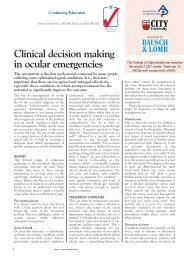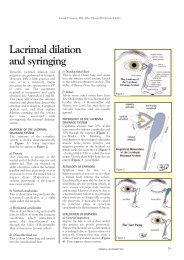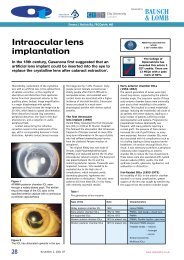Create successful ePaper yourself
Turn your PDF publications into a flip-book with our unique Google optimized e-Paper software.
CONTINUING EDUCATION AND TRAINING<br />
Gain 2 CET credits - enter online at www.otcet.co.uk or by post<br />
Module questions<br />
Course code: c-4090<br />
Please note, <strong>the</strong>re is only one correct answer. Enter online or by form provided.<br />
1. For a highly irregular corneal topography would you<br />
try as first choice...<br />
a. Non-ventilated impression RGP scleral lens?<br />
b. Preformed fenestrated RGP scleral lens?<br />
c. Fenestrated impression PMMA scleral lens?<br />
d. Non-ventilated preformed RGP scleral lens?<br />
2. What is <strong>the</strong> optimum corneal clearance for a<br />
non-ventilated RGP scleral lens?<br />
a. Not more than 0.1mm<br />
b. Not less than 1.0mm<br />
c. Between 0.2mm and 0.3mm<br />
d. Between 0.4mm and 0.9mm<br />
3. If <strong>the</strong> BSR is changed from 13.50mm to 14.50mm<br />
without altering <strong>the</strong> OZP, would you expect...<br />
a. Increased apical clearance<br />
b. Reduced apical clearance<br />
c. There would be no difference<br />
d. There would be increased vaulting from <strong>the</strong> scleral zone<br />
4. What is <strong>the</strong> most probable objective when<br />
fenestrating an RGP scleral lens?<br />
a. To enable easier handling<br />
b. To increase apical clearance<br />
c. To create corneal contact<br />
d. To give a crescent-shaped bubble under <strong>the</strong> lens<br />
5. What is <strong>the</strong> usual objective when fenestrating a<br />
PMMA scleral lens?<br />
a. To give a crescent shaped bubble<br />
b. To increase apical clearance<br />
c. To facilitate oxygenated tear exchange<br />
d. To create corneal contact<br />
6. What would be <strong>the</strong> reason for considering a scleral<br />
lens in moderate keratoconus?<br />
a. To improve on vision achieved with a corneal lens<br />
b. To give increased oxygenation<br />
c. To alleviate corneal contact<br />
d. To create corneal contact<br />
7. Comparing small and large diameter non-ventilated<br />
scleral lenses, would you expect...<br />
a. More limbal clearance with <strong>the</strong> smaller lens?<br />
b. More apical clearance with <strong>the</strong> smaller lens?<br />
c. Better tear pool retention with <strong>the</strong> larger lens?<br />
d. The smaller lens to be more stable on <strong>the</strong> eye?<br />
8. What is <strong>the</strong> most common modern indication for<br />
scleral lenses?<br />
a. Aphakia<br />
b. High myopia<br />
c. Keratoconus<br />
d. Corneal transplant fitted post-operatively<br />
9. What is meant by <strong>the</strong> term sealed in <strong>the</strong> context of<br />
scleral lens practice?<br />
a. Near perfect alignment to <strong>the</strong> cornea<br />
b. Near perfect alignment to <strong>the</strong> sclera<br />
c. A lens retaining an air bubble-free tear pool<br />
d. A lens which is very difficult to remove<br />
10. Under what circumstances could a PMMA scleral be<br />
arguably preferable to an RGP scleral?<br />
a. For keratoconus<br />
b. Never<br />
c. For aphakia<br />
d. For work in dusty environments<br />
11. If <strong>the</strong> BSR is changed from 14.50mm to 13.50mm, & <strong>the</strong> OZP<br />
is increased one clinically significant step, would you expect...<br />
a. An 0.25mm increase in <strong>the</strong> apical clearance?<br />
b. A 0.50mm or greater increase in <strong>the</strong> apical clearance?<br />
c. No change in <strong>the</strong> apical clearance?<br />
d. A reduction in apical clearance of 0.25mm?<br />
12. What would be <strong>the</strong> probable outcome of reducing <strong>the</strong> diameter<br />
of a non-ventilated RGP scleral lens from 23mm to 18mm?<br />
a. Increased apical clearance<br />
b. More decentration of <strong>the</strong> lens<br />
c. An apical contact zone<br />
d. More chance of <strong>the</strong> lens falling out<br />
An answer return form is included in this issue.<br />
It should be completed and returned to:<br />
CET initiatives (c-4090), OT, McMillan Scott, 9 Savoy Street, London, WC2E 7HR by November 15. Under no circumstances will forms received after this date be<br />
marked – <strong>the</strong> answers to <strong>the</strong> module will be published in our December 15 issue.<br />
OT Book Shop<br />
Why not purchase your educational books through <strong>the</strong> OT Bookshop.<br />
You can do this by calling our customer services team on 020 7878 2300 and ask for <strong>the</strong> Angela or Louise in <strong>the</strong> OT Bookshop.<br />
Also you can log on to www.optometry.co.uk and select OT Bookshop.<br />
We do our best to deliver usually within 7 working days, however some titles may take up to 28 days depending on stock availability. If <strong>the</strong>re<br />
are any o<strong>the</strong>r titles that you are interested in but cannot see <strong>the</strong>m on our site, please contact us as we will do our best to make available all<br />
titles which are in print. Should you have any queries about an order please feel free to call us as we will be more than happy to assist you.<br />
33 | October 20 | 2006 | OT
















